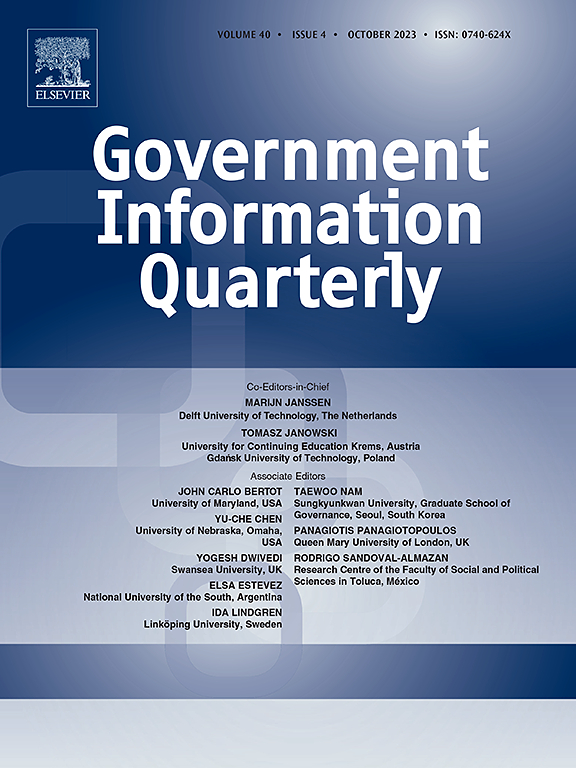数字政府中的公民中心:理论与实证类型学
IF 10
1区 管理学
Q1 INFORMATION SCIENCE & LIBRARY SCIENCE
引用次数: 0
摘要
将公民作为政策制定或服务设计过程的基石通常被称为以公民为中心,并且通常被认为是数字政府转型背景下的关键实践。然而,缺乏对公民中心性的共同理解导致了实践和理论上的困难,其中包括多种异质定义所产生的混乱以及衡量数字倡议的公民中心性水平的困难,这只是其中两个。作为答案,本研究通过提出一种基于理论和实践的类型来表征公民中心主义。它通过对最近的科学文献进行调查,对58项研究进行了系统的文献回顾,并结合了对公共代理人的14次定性访谈。我们以公民为中心的类型学的主要贡献有三个方面。首先,通过强调对公民中心的四种理解,有时指的是最终结果、设计过程、治理模式或识别用户的方式,我们证明了这一概念有可能涵盖多种不同的现实。此外,它提供了一个理解这一概念的关键视角,从而促进了追求公民中心的利益相关者之间的协调。其次,我们确定了每种理解的文献和实践者所赋予的特征。最后,我们认为公民中心的四种理解不能被排序,甚至是迭代的,因为它们是不断相互作用的。这些贡献应该指导未来的研究,并促进研究与实践之间的交流。本文章由计算机程序翻译,如有差异,请以英文原文为准。
Citizen-centricity in digital government: A theoretical and empirical typology
Putting citizens as the cornerstone of a policymaking or service design process is usually referred to as citizen-centricity and is often considered a key practice in the context of digital government transformation. Nevertheless, the lack of a common comprehension of what citizen-centricity entails leads to practical and theoretical difficulties, among which the confusion generated by the multiple heterogeneous definitions and the difficulty of measuring the level of citizen-centricity of a digital initiative, to cite only two. As an answer, this study characterizes citizen-centricity by suggesting a typology grounded in theory and practice. It does so by surveying the recent scientific literature using a systematic literature review of 58 studies, combined with 14 qualitative interviews with public agents. The key contribution from our citizen-centricity typology is threefold. First, by emphasizing four understandings of citizen-centricity, sometimes referring to an end-result, a design process, a governance mode, or a way of identifying the user, we demonstrate that the concept has the potential to encompass a multitude of disparate realities. Furthermore, it provides a crucial lens through which to comprehend the concept, thereby facilitating alignment between stakeholders engaged in the pursuit of citizen-centricity. Second, we identify the characteristics given by the literature and practitioners for each understanding. Finally, we suggest that the four understandings of citizen-centricity cannot be sequenced, even iteratively, since they interact continuously. These contributions should guide future research and facilitate communication between research and practice about this concept.
求助全文
通过发布文献求助,成功后即可免费获取论文全文。
去求助
来源期刊

Government Information Quarterly
INFORMATION SCIENCE & LIBRARY SCIENCE-
CiteScore
15.70
自引率
16.70%
发文量
106
期刊介绍:
Government Information Quarterly (GIQ) delves into the convergence of policy, information technology, government, and the public. It explores the impact of policies on government information flows, the role of technology in innovative government services, and the dynamic between citizens and governing bodies in the digital age. GIQ serves as a premier journal, disseminating high-quality research and insights that bridge the realms of policy, information technology, government, and public engagement.
 求助内容:
求助内容: 应助结果提醒方式:
应助结果提醒方式:


